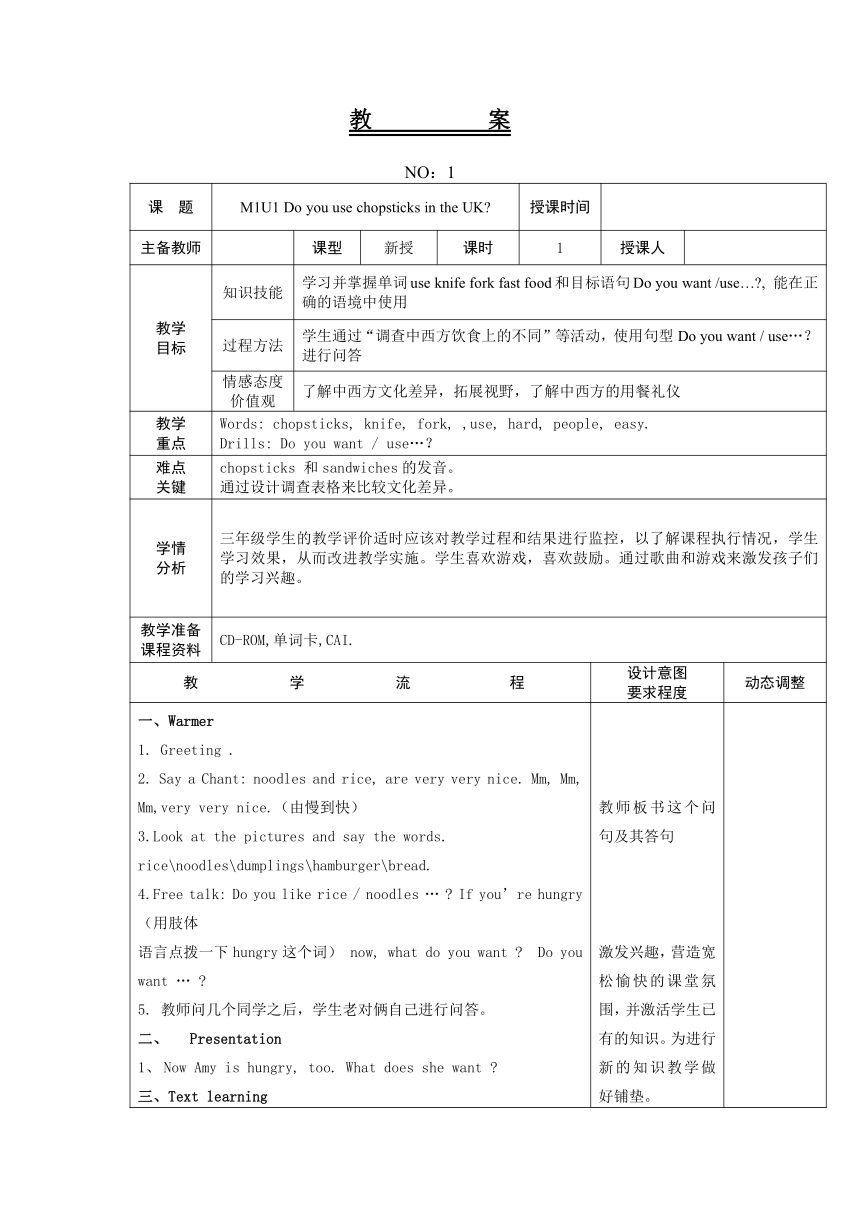Module 1 Unit 1 Do you use chopsticks in UK 教案(表格式)
文档属性
| 名称 | Module 1 Unit 1 Do you use chopsticks in UK 教案(表格式) |  | |
| 格式 | doc | ||
| 文件大小 | 34.5KB | ||
| 资源类型 | 教案 | ||
| 版本资源 | 外研版(一年级起点) | ||
| 科目 | 英语 | ||
| 更新时间 | 2022-05-18 16:49:38 | ||
图片预览

文档简介
教 案
NO:1
课 题 M1U1 Do you use chopsticks in the UK 授课时间
主备教师 课型 新授 课时 1 授课人
教学目标 知识技能 学习并掌握单词use knife fork fast food和目标语句Do you want /use… , 能在正确的语境中使用
过程方法 学生通过“调查中西方饮食上的不同”等活动,使用句型Do you want / use…?进行问答
情感态度价值观 了解中西方文化差异,拓展视野,了解中西方的用餐礼仪
教学重点 Words: chopsticks, knife, fork, ,use, hard, people, easy. Drills: Do you want / use…?
难点关键 chopsticks 和sandwiches的发音。通过设计调查表格来比较文化差异。
学情分析 三年级学生的教学评价适时应该对教学过程和结果进行监控,以了解课程执行情况,学生学习效果,从而改进教学实施。学生喜欢游戏,喜欢鼓励。通过歌曲和游戏来激发孩子们的学习兴趣。
教学准备课程资料 CD-ROM,单词卡,CAI.
教 学 流 程 设计意图要求程度 动态调整
一、Warmer1. Greeting .2. Say a Chant: noodles and rice, are very very nice. Mm, Mm, Mm,very very nice.(由慢到快)3.Look at the pictures and say the words.rice\noodles\dumplings\hamburger\bread.4.Free talk: Do you like rice / noodles … If you’re hungry(用肢体语言点拨一下hungry这个词) now, what do you want Do you want … 5. 教师问几个同学之后,学生老对俩自己进行问答。 PresentationNow Amy is hungry, too. What does she want 三、Text learning1、Ss listen, find and answer. Ss underline the sentences: Do you want noodles Yes, please.2、T:Amy wants noodles. What does she use (1)学生汇报:She uses chopsticks.(课件)If you want noodles, do you use chopsticks (连续问几个同学)⑵、Yes, we use chopsticks in China.⑶、在课文中,Daming也问了Amy一个类似的问题,请你找一找,画一画。⑷、学生汇报:Do you use chopsticks in England ,教师板书。 ⑸、那么Amy又是怎么回答的呢?学生在书上找,教师教学knife and fork及使用方法。⑹、教师教说并让学生采用实物体会操练:We use chopsticks. It’s easy for Chinese people. / We don’t use a knife and fork. It’s hard for Chinese people. ⑺、小结:不同的国家有不同的用餐习俗,中西饮食文化的餐具差异。8)、Read the text after the recorder.四.Practice1、Fill in the blanks.A guessing game, 操练问句:Do you use… 五、Production(当堂检测)1、继续调查,搜集资料,了解中西方在其它方面的差异。六、Summary and Homework1.Summary.⑴本课应会词组。⑵英文书信的格式。2.Homework.(1)Read the text.(2)Copy the words. 教师板书这个问句及其答句激发兴趣,营造宽松愉快的课堂氛围,并激活学生已有的知识。为进行新的知识教学做好铺垫。拼写单词并指导书写教师板书,学生分小组比赛读。
作业设计 (1)Read the text.(2)Copy the words.
板书设计 Module1 Unit1Do you use chopsticks in the UK No, we don’t.We use a knife and fork.
反思
NO:1
课 题 M1U1 Do you use chopsticks in the UK 授课时间
主备教师 课型 新授 课时 1 授课人
教学目标 知识技能 学习并掌握单词use knife fork fast food和目标语句Do you want /use… , 能在正确的语境中使用
过程方法 学生通过“调查中西方饮食上的不同”等活动,使用句型Do you want / use…?进行问答
情感态度价值观 了解中西方文化差异,拓展视野,了解中西方的用餐礼仪
教学重点 Words: chopsticks, knife, fork, ,use, hard, people, easy. Drills: Do you want / use…?
难点关键 chopsticks 和sandwiches的发音。通过设计调查表格来比较文化差异。
学情分析 三年级学生的教学评价适时应该对教学过程和结果进行监控,以了解课程执行情况,学生学习效果,从而改进教学实施。学生喜欢游戏,喜欢鼓励。通过歌曲和游戏来激发孩子们的学习兴趣。
教学准备课程资料 CD-ROM,单词卡,CAI.
教 学 流 程 设计意图要求程度 动态调整
一、Warmer1. Greeting .2. Say a Chant: noodles and rice, are very very nice. Mm, Mm, Mm,very very nice.(由慢到快)3.Look at the pictures and say the words.rice\noodles\dumplings\hamburger\bread.4.Free talk: Do you like rice / noodles … If you’re hungry(用肢体语言点拨一下hungry这个词) now, what do you want Do you want … 5. 教师问几个同学之后,学生老对俩自己进行问答。 PresentationNow Amy is hungry, too. What does she want 三、Text learning1、Ss listen, find and answer. Ss underline the sentences: Do you want noodles Yes, please.2、T:Amy wants noodles. What does she use (1)学生汇报:She uses chopsticks.(课件)If you want noodles, do you use chopsticks (连续问几个同学)⑵、Yes, we use chopsticks in China.⑶、在课文中,Daming也问了Amy一个类似的问题,请你找一找,画一画。⑷、学生汇报:Do you use chopsticks in England ,教师板书。 ⑸、那么Amy又是怎么回答的呢?学生在书上找,教师教学knife and fork及使用方法。⑹、教师教说并让学生采用实物体会操练:We use chopsticks. It’s easy for Chinese people. / We don’t use a knife and fork. It’s hard for Chinese people. ⑺、小结:不同的国家有不同的用餐习俗,中西饮食文化的餐具差异。8)、Read the text after the recorder.四.Practice1、Fill in the blanks.A guessing game, 操练问句:Do you use… 五、Production(当堂检测)1、继续调查,搜集资料,了解中西方在其它方面的差异。六、Summary and Homework1.Summary.⑴本课应会词组。⑵英文书信的格式。2.Homework.(1)Read the text.(2)Copy the words. 教师板书这个问句及其答句激发兴趣,营造宽松愉快的课堂氛围,并激活学生已有的知识。为进行新的知识教学做好铺垫。拼写单词并指导书写教师板书,学生分小组比赛读。
作业设计 (1)Read the text.(2)Copy the words.
板书设计 Module1 Unit1Do you use chopsticks in the UK No, we don’t.We use a knife and fork.
反思
同课章节目录
- Module 1
- Unit 1 Do you use chopsticks in England?
- Unit 2 I'm eating hamburgers and chips.
- Module 2
- Unit 1 We're making a cake.
- Unit 2 I'm watching TV.
- Module 3
- Unit 1 These ducks are very naughty.
- Unit 2 The ducks are playing in the rain.
- Module 4
- Unit 1 I can jump far.
- Unit 2 What can you see?
- Module 5
- Unit 1 Can I have an ice cream?
- Unit 2 Can I come in?
- Module 6
- Unit 1 I've got new shorts and new shoes.
- Unit 2 He's got a new shirt.
- Module 7
- Unit 1 Have you got a headache?
- Unit 2 She's got a cold.
- Module 8
- Unit 1 This is Sam's book
- Unit 2 Is this your grandma's umbrella?
- Module 9
- Unit 1 I'm going to do long jump?
- Unit 2 I'm going to be a driver.
- Module 10
- Unit 1 Are you going to go to Hong Kong?
- Unit 2 What are you going to see?
- Review Module
- Unit 1
- Unit 2
